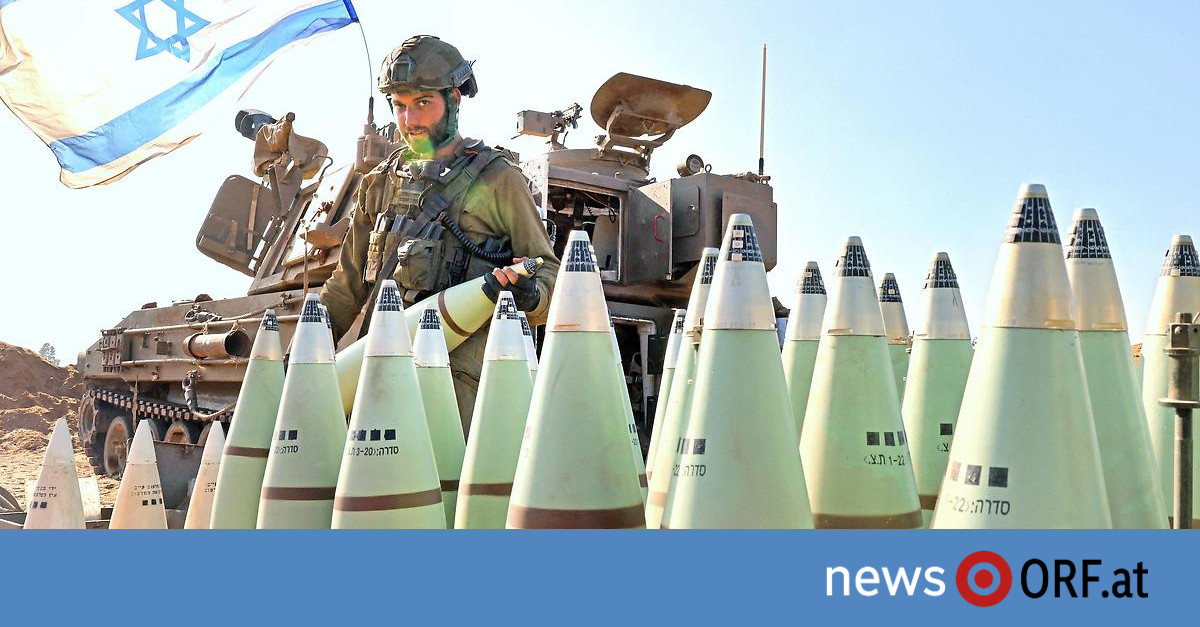In the joint conversation, Austin stressed that the United States and Israel have a “moral obligation” to protect civilians in the Gaza Strip, the Pentagon said after the meeting. It also has a “strategic interest”.
Austin called on Gallant to expand humanitarian access and resolve supply problems within the Gaza Strip. “The United States remains committed to preventing all regional actors from exploiting or expanding the conflict beyond the Gaza Strip,” the US defense secretary also clarified.
Shortage of artillery shells
Indeed, another question may be at the heart of the meeting – namely the provision of military aid to Israel, particularly the urgently needed ammunition. In some cases, the Israeli military does not have the same munitions as Ukraine, especially the same caliber of artillery shells that Ukraine needs and that are common in NATO.
But more than two years since the start of Russia's invasion of Ukraine, there has been an increasingly complex disruption to production. Production is drastically reduced – virtually no NATO scenario envisages large-scale use of artillery and tanks for warfare in the 21st century. But in both Ukraine and Gaza — and with Hezbollah, a secondary front for Lebanon in the north — these kinds of weapons are of central importance.
Same capacity as Ukraine
According to Haaretz, all Israeli howitzers use the 155 mm caliber, which is also the NATO standard. The Ukrainian military also uses this capability. According to Haaretz, the price of bullets has quadrupled since the Russian attack. The US plans to increase production to 80,000 units per month this year. However, Ukraine alone needs 200,000 per month. 155 mm projectiles are a significant part of US military supplies to Israel after October 7.
“Prehistoric Devices”
The problem primarily affects militia units that fight with older guns — not least because they're trained to do so. Militia units are now stationed only on the Lebanese border. The howitzers in these units are several generations of the M109 model, which has been in service since 1963. Haaretz's research is based on reports from some fighters stationed in Gaza and along the Lebanese border.
One recounted that at the beginning of their mission against Hezbollah, half of the equipment forwarded to them was not working. Some of these are “prehistoric devices”.
Advancing players were cheated
A militia officer stationed in Gaza said that higher-ups had instructed them to report to their fire support unit that they had fired as many grenades as requested – but in reality they should have fired a third or a quarter less. The officer explained to Haaretz that trust between the advancing soldiers and the gunners who select targets is key. Suddenly you find yourself in a situation where you are not telling them the truth.
Chaotic ammo redistribution
In some cases, ammunition went missing for days, used for protection as troops advanced. The savings made here meant that in some cases even more ammunition would have been needed – meaning troops could be engaged in heavy fighting outside the combat zone.
Ammunition supply was sometimes chaotic. Sometimes nothing arrived for days, and some ammunition was unusable. Some of them are cartridges with different ranges or different product series. Whether with the same ammunition or a different production series, each howitzer must be recalibrated, requiring two to three rounds of ammunition.
With a unit of 15 howitzers, dozens of projectiles must be fired pointlessly in the open. This meant that ammunition had to be constantly transported back and forth between individual howitzers during combat. As the range of ammunition was sometimes different, the howitzers had to be repeatedly moved several kilometers. As a result, even soldiers who fought in the Second Lebanon War already in 2006 could not remember such confusion.
“Bullet Roulette” with Ancient Ammunition
The highlight of “Bullet Roulette,” as Haaretz called it, was the use of ammunition, the ammunition of which was about 70 years old. It produced a large amount of smoke and would have been less accurate, but would have worn the howitzer barrels more than ordinary ammunition.

Prepare for many scenes
Israel must also prepare itself for several scenarios when it comes to ammunition: the war continues as it has for months – meaning a massive deployment of resources in Gaza and, albeit significantly less, daily, limited attacks with Hezbollah in the north. The second scenario is an escalation with Hezbollah with an invasion of southern Lebanon. Israel wants to prepare for a third, currently unlikely scenario: a multi-front war, including direct conflict with Syria and increased rocket attacks by the Houthis.
Debate about the military's misguided strategic orientation has also resurfaced in recent years. Like NATO, Israel's general staff was based primarily on hybrid warfare, and there were significant savings in artillery and tank units.
Risk for many years
In the future, the munitions used are likely to cause additional problems: never before have so many munitions been fired into Gaza – including many unexploded bombs. Even if the ongoing humanitarian disaster ends, these will continue to endanger the people of Gaza for years to come. But probably for Israel, too: According to Israeli military experts, unexploded bombs have already been an important “source of raw materials” for the Hamas terrorist group's production of Katyusha rockets.

